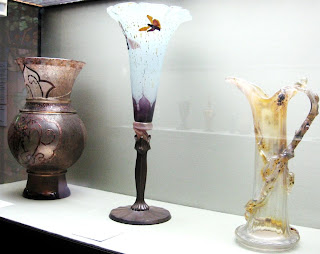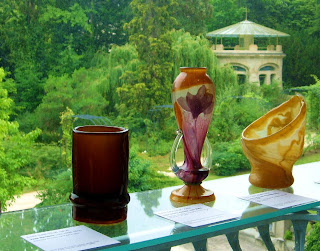Saturday 25th June 2011, Nancy, France
We have spent another stunning day around the city and could easily spend several more without exhausting the artistic treasures on offer.
What I'm writing below is intended mainly to help me to understand. I do not pretend to know very much about art, or indeed much else in any depth. However, I just love the complete change from the accepted, earlier approaches to the arts and architecture before Art Nouveau burst upon the scene. It was a movement that spread across Europe for just a brief period covering the last decade of the 19th century and the early years of the twentieth. It was known also by other names – Secessionist or Arts and Crafts. Each country had its own characteristics. Sometimes earlier architectural styles were combined to create a hybrid style known as Eclectic but this, although often extravagant, did not have the flowing lines of Art Nouveau. Nancy played a leading role as this new, exuberant artistic style developed in France. It was fortunate to have a number of highly gifted craftsmen, willing and able to work together to create holistic works of art. Thus an architect would create the building with features that co-ordinated with, and complemented the contents created by interior designers, woodcarvers, carpenters, glass and ceramic artists. Wood or metal frames would be designed for the paintings or mirrors they would contain, stained glass lampshades would be created for a specifically designed brass or metal fitment which would be artistic masterpieces in their own right.
It was a totally new concept, influenced by the flowing lines of Japanese art and frequently imitating nature - reproducing fruits, flowers, birds, dragon flies and other insects. It was a move away from the previous gothic or heavy Victorian designs, or earlier religious and ecclesiastical art. Rather than being pure art for art's sake, it theoretically served a practical purpose – a building, an architectural feature, a piece of furniture, a dinner service, a jardinière or a leather book binding. All these were secondary though to the artistic merit of the embellishment. But they were so alive, beautiful and generally such fun!
So today we sought out the Musée de l'Ecole de Nancy. The museum occupies an appropriate Art Nouveau house set in a pleasant garden with suitable period features. These include a summerhouse/aquarium, an elaborate Art Nouveau funerary monument combining stone, metal and stained glass, metal garden chairs scattered around the grounds and the original carved wooden doors of the Emile Gallé workshop.




The interior of the museum clearly showed that it had once been a private residence, built and decorated in the Art Nouveau style. It was not just the exhibits, but the setting that created such a huge impression. Flooring, ceilings, windows, doors and fitments, even radiators, were designed to co-ordinate with the soft furnishings, glass, ceramics, paintings, picture frames, clocks, lamps and domestic furniture displayed within.

Mahogany and oak tables and dressers, inlaid with woods, filigree metal and mother of pearl, with their aesthetically appealing lines, curving embellishments and bevelled glass mirrors were all far too fine to actually accommodate everyday belongings. The only ornamentation worthy of display would have to be single items of decorative glassware from the workshops of the Daum brothers or Emile Gallé.













Where cabinets filled with coloured glass vases were displayed, the cabinets themselves were frequently as worthy of admiration as the contents, beautifully decorated with stained glass tops, the bevelled glass sides held together by decorative iron or wooden frames.














Amongst the most beautiful and colourful items in the house were the stained and painted coloured glass surrounding windows, on staircases, in entrance lobbies or even dividing rooms. Some of these were huge, filled with fruits and flowers or depicting landscapes filled with birds, insects, plants and animals.




Nancy was famous too for its horticultural activities. Duke Stanislas set up the first botanical garden here in the 18th century, a tradition that still continues today with what later became known as the Jardin Godron, delightfully laid out with labelled specimens of herbs and plants in raised beds surrounded by tiny box hedges.

The centenary of one of the members of the Nancy School, Le Moine, who died in 1911, is currently being remembered here. He was a horticulturalist and developed new strains of flowers, particularly double fuschias and peonies. He was jointly responsible with Emile Gallé for establishing the Société Centrale de Horticulture de Nancy. They worked co-operatively together, thus Gallé and his atelier workers had ready access to new and rare plants to reproduce on hand painted ceramics or fuse into stunning coloured glass vases.
We spent hours in the museum which complements the Musée des Beaux Arts which we visited on our previous stay. It is incredible just how much there is to see in these two museums, both primarily dedicated to works produced within the city. As we were leaving we asked about the house of Louis Marjorelle another leading exponent who worked chiefly in wood and metal, producing and decorating furniture and decorative ironwork. Regrettably visits are by appointment only and those for today and tomorrow are already oversubscribed. So there is nothing for it, we will just have to return again one day. What a hardship! We did though seek out his home which was worth visiting just to see from the outside.




We understood there was a brocante fair with an Art Nouveau theme in the Parc Sainte Marie, but we were a day too early. A walk through the grounds though revealed a statue of Le Moine honouring his centenary. Much of the layout of the park was attributable to him.

Lunch today was taken at Flunch, a large, cheap, chain restaurant found in cities across France offering excellent value for money. We had fried fish with as many vegetable as we could eat – and we were pretty hungry by this time so the croquettes, runner beans and creamed asparagus were piled on pretty high, together with chocolate tart for Ian and a couple of large coffees. It was all very enjoyable.
A wander around the busy shopping centre on a Saturday afternoon was quite fun with a group of saxophonists in bright clothes entertaining the shoppers and an excellent covered market filled with fresh fish, meat, vegetables, cheeses, jams, cakes and deli products.


As we made our way back for a last gaze around the Place Stanislas Leszczynski before leaving Nancy we "mopped-up" the final few buildings of particular merit in a city crowded with attractive buildings. Worthy of mention was the eclectic facade of the Credit Lyonnais bank and the decorative glass canopy covering the banking hall within.


Back in the Place Stanislas Leszczynski a wedding had just taken place in the town hall so the main doors were open wide. We seized the opportunity to slip inside and photograph the main staircase. From the balcony the newly-weds gazed happily down on their wedding guests. This looked just as satisfying as William and Kate's recent appearance on the balcony at Buckingham Palace - indeed, the setting here was just as splendid and readily available to all the wedding couples of Nancy!


Please, please read our earlier account of Nancy. We've tried not to repeat ourselves this time and this is just a summary of a couple of days crowded with highlights. It's the best place ever!!
Related links:
Nancy

